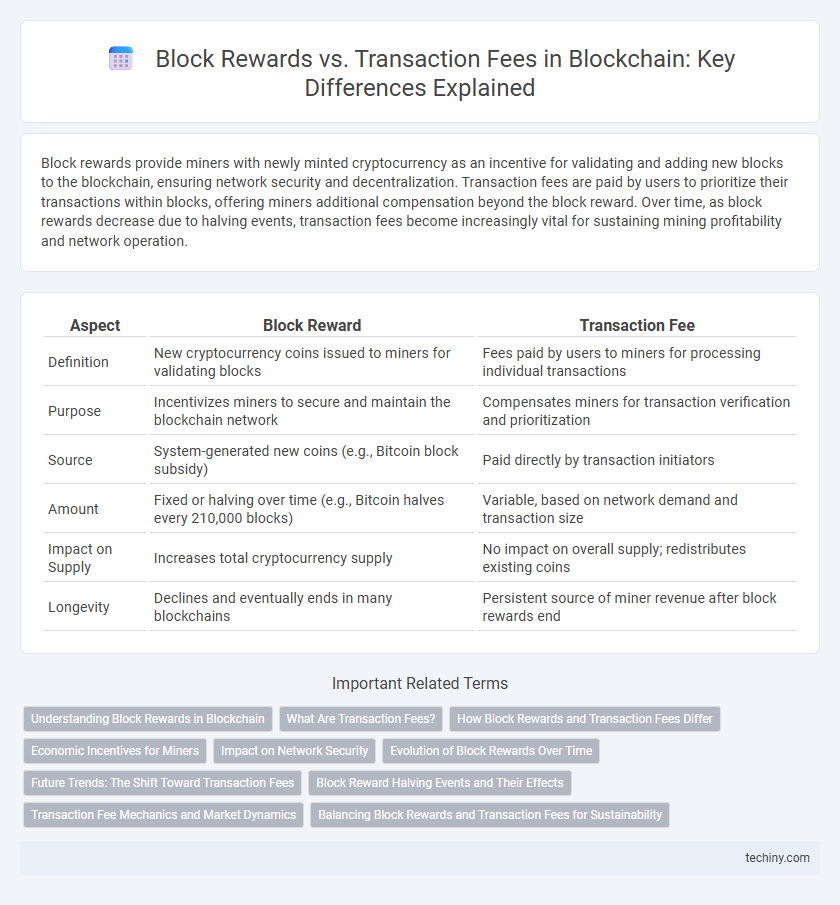Block rewards provide miners with newly minted cryptocurrency as an incentive for validating and adding new blocks to the blockchain, ensuring network security and decentralization. Transaction fees are paid by users to prioritize their transactions within blocks, offering miners additional compensation beyond the block reward. Over time, as block rewards decrease due to halving events, transaction fees become increasingly vital for sustaining mining profitability and network operation.
Table of Comparison
| Aspect | Block Reward | Transaction Fee |
|---|---|---|
| Definition | New cryptocurrency coins issued to miners for validating blocks | Fees paid by users to miners for processing individual transactions |
| Purpose | Incentivizes miners to secure and maintain the blockchain network | Compensates miners for transaction verification and prioritization |
| Source | System-generated new coins (e.g., Bitcoin block subsidy) | Paid directly by transaction initiators |
| Amount | Fixed or halving over time (e.g., Bitcoin halves every 210,000 blocks) | Variable, based on network demand and transaction size |
| Impact on Supply | Increases total cryptocurrency supply | No impact on overall supply; redistributes existing coins |
| Longevity | Declines and eventually ends in many blockchains | Persistent source of miner revenue after block rewards end |
Understanding Block Rewards in Blockchain
Block rewards are the primary incentives given to miners for validating and adding new blocks to the blockchain, consisting of newly minted cryptocurrency tokens. These rewards ensure network security and decentralization by motivating miners to maintain consensus and process transactions. Transaction fees provide supplementary income but are typically smaller compared to block rewards, especially in early stages of blockchain networks.
What Are Transaction Fees?
Transaction fees are the small amounts of cryptocurrency paid by users to incentivize miners to include their transactions in a blockchain. These fees help prioritize transactions, especially during network congestion, ensuring faster confirmation times. Unlike block rewards, which are newly minted coins awarded to miners, transaction fees are paid by users and vary based on network demand and transaction size.
How Block Rewards and Transaction Fees Differ
Block rewards are newly minted cryptocurrency tokens awarded to miners for validating and adding a new block to the blockchain, serving as a primary incentive during early network phases. Transaction fees are smaller payments users include with their transactions to prioritize processing and secure miner attention when network demand increases. While block rewards decrease over time through programmed halvings, transaction fees become the dominant incentive sustaining miner operations in mature blockchain networks.
Economic Incentives for Miners
Block rewards provide miners with new cryptocurrency units as a primary economic incentive, ensuring network security and encouraging participation in block validation. Transaction fees complement block rewards by offering miners additional income proportional to network demand and transaction volume, especially as block rewards diminish over time due to halving events. This dual incentive structure balances miner profitability and network stability, driving sustained blockchain maintenance and scalability.
Impact on Network Security
Block rewards provide miners with newly minted cryptocurrency, offering a consistent financial incentive that supports robust network security by encouraging continuous mining activity. Transaction fees, which vary based on network congestion and transaction size, supplement miner income but can fluctuate, potentially impacting miners' willingness to validate transactions during low-fee periods. A balanced combination of block rewards and transaction fees is essential to maintain sufficient miner participation, ensuring strong decentralization and protection against 51% attacks.
Evolution of Block Rewards Over Time
Block rewards have undergone significant evolution since the inception of blockchain networks, initially serving as the primary incentive for miners to validate transactions and secure the network. Over time, block rewards decrease systematically through events known as "halving," reducing the number of new coins generated with each block and gradually shifting the economic focus toward transaction fees. This transition emphasizes the importance of transaction fees in maintaining miner incentives as block rewards diminish, ensuring continued network security and sustainability.
Future Trends: The Shift Toward Transaction Fees
Blockchain networks are witnessing a gradual shift where transaction fees increasingly dominate over block rewards as the primary miner incentive, driven by the halving of block rewards in cryptocurrencies like Bitcoin. This transition encourages miners to prioritize transaction throughput and fee optimization, fostering advanced fee market mechanisms and scalability solutions such as layer-2 protocols. Future trends indicate a move toward sustainable mining economics reliant on dynamic fee structures rather than fixed block subsidies.
Block Reward Halving Events and Their Effects
Block reward halving events significantly reduce the number of new bitcoins miners receive, directly impacting miner revenue and blockchain security incentives. As block rewards diminish, transaction fees become increasingly vital for sustaining mining profitability and network consensus. Historical data from Bitcoin halvings reveal temporary increases in transaction fees and market volatility, underscoring the importance of fee markets in a post-halving ecosystem.
Transaction Fee Mechanics and Market Dynamics
Transaction fee mechanics in blockchain incentivize miners or validators by compensating for transaction processing and network security beyond the fixed block reward. Market dynamics influence transaction fees as users compete to prioritize their transactions, causing fees to fluctuate based on network congestion and demand. Dynamic fee algorithms, such as Ethereum's base fee adjustment mechanism, optimize fee market efficiency and enhance user experience during peak activity.
Balancing Block Rewards and Transaction Fees for Sustainability
Balancing block rewards and transaction fees is essential for the long-term sustainability of blockchain networks, particularly as block rewards halve over time in protocols like Bitcoin. Higher transaction fees help incentivize miners to continue validating transactions as block rewards diminish, ensuring network security and reliability. Effective fee market mechanisms and dynamic adjustment models support this equilibrium to maintain robust blockchain operations.
Block reward vs Transaction fee Infographic

 techiny.com
techiny.com